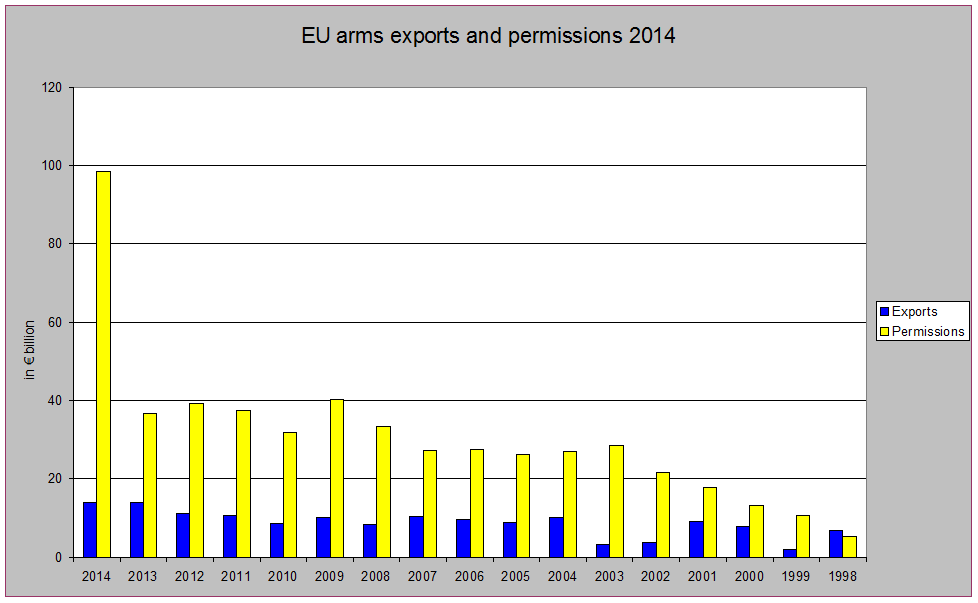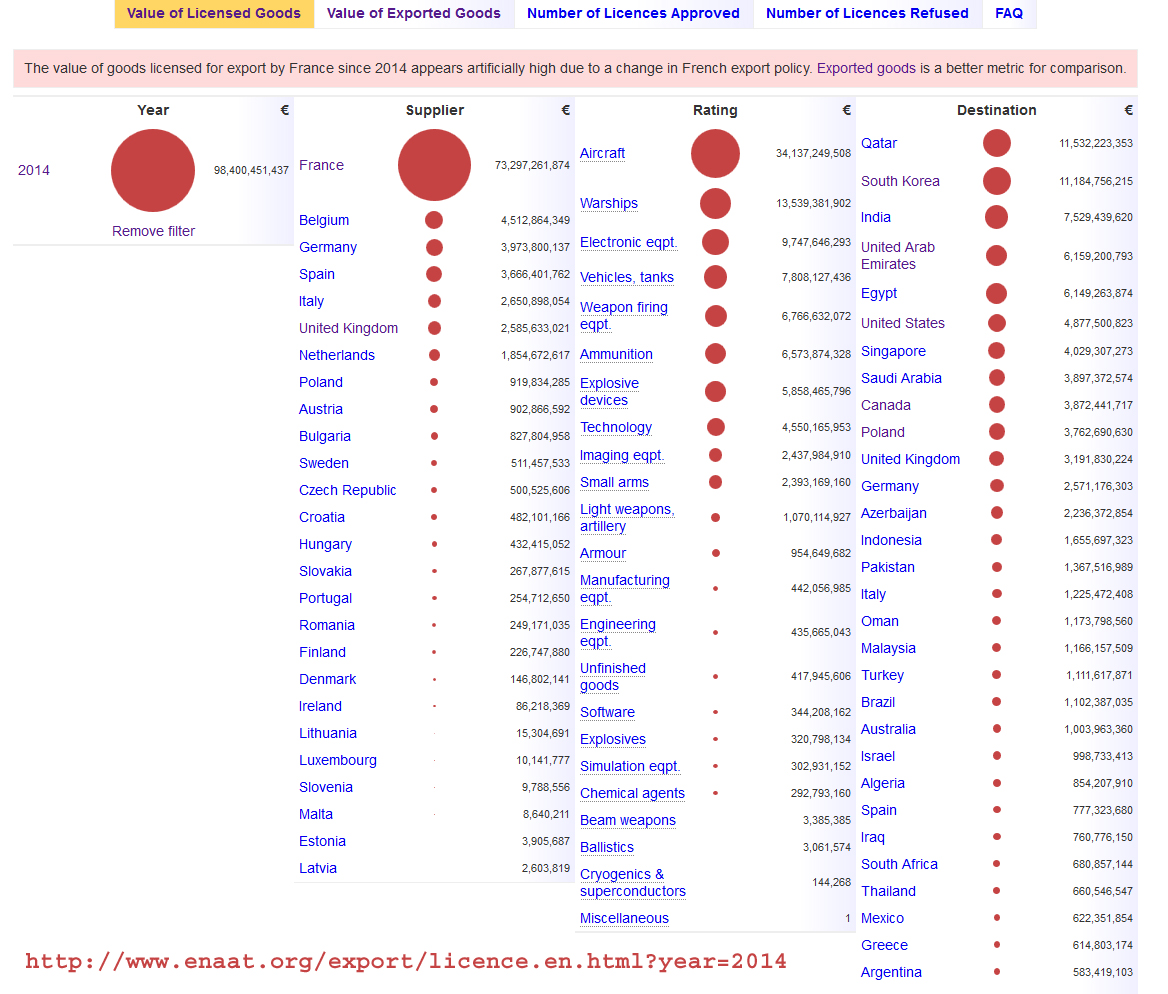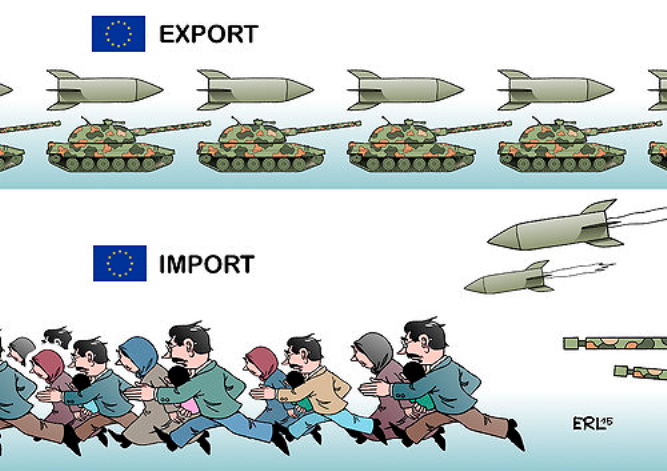
‘Better late than never,’ wrote an anti arms trade activist from London when the 2014 EU Consolidated report on arms exports finally became public in March 2016. The official presentation to the EU parliament will take place in April. The report was always late, in the recent past it was published in October/November of the following year, partly due to the complicated process of obtaining and organizing facts and figures from 28 member states with 28 methods of reporting. But this late publication makes democratic control more or less a farce: arms export figures from January 2014 will be discussed 27 months after export permissions were actually granted or the weapons exported. If the European Union and its Member States take arms trade control serious, this must improve.
The report is not only late but it is also a two weeks job to read the information. It is over 650 pages long. Pages filled with tables on the arms exports, arms exports permissions and license refusals of the 28 member states. All this information makes it a gig bowl of a grey macaroni of figures without a text sauce to digest it. Exports are divided in destinations and classes of military equipment. Exports go to 159 different countries in the world and export permissions are even given for 184 destinations (of about 195 nations in the world). The permissions give us a look into the polices of governments (which countries are acceptable, for what type of military products) and into the future of EU arms trade, because the permissions of today are the exports of tomorrow. But they are also a rather significant overestimation of potential arms export opportunities (see table). The exports figures show us which permissions materialised. Concerning exports, Saudi Arabia is the EU’s biggest client, with € 1.4 billion of arms and military equipment bought. The biggest client when looking at permissions is Qatar, with € 11 billion and the smallest is Papua New Guinea with only € 80.
But there is an easy application to find a way through this overload of information. Made possible by Ian Mackinnon in 2013 for a project by the European Network Against Arms Trade in collaboration with CAAT from London (with translation into French and German and even help from COARM, the EU body concerning arms export policy, tracing and correcting errors in the official data). The application makes the information on EU arms export easily available and enables to search on all different aspects. The results are visualised by circles representing the financial value or numbers of licenses. This makes the report more valuable and an interesting source of information with almost endless scopes for analysis. The info maybe too late and too old, but at the same time it is also a collection of official figures nowhere to be found together and all in English.
 The figures show some worrying trends. Saudi Arabia is again the most prominent client for European arms deliveries in 2014. Almost €1.5 billion was sold by France, Spain. Italy, the Czech Republic Finland, Sweden and several other countries. The Wahhabi Kingdom is also the most prominent EU arms destination for the last fifteen year. Among the big clients of European arms in 2014 we also find Algeria, Morocco, India, the UAE and Turkey. When you consider the poverty in some of these countries, or the involvement in regional or internal conflict in others it is astonishing that governments consider them legal destinations for a European Union following an ethical arms trade policy. For Saudi Arabia this argument is even stronger, in the light of a recently adopted European parliament resolution calling for an end of arms export to thye Saudi’s.
The figures show some worrying trends. Saudi Arabia is again the most prominent client for European arms deliveries in 2014. Almost €1.5 billion was sold by France, Spain. Italy, the Czech Republic Finland, Sweden and several other countries. The Wahhabi Kingdom is also the most prominent EU arms destination for the last fifteen year. Among the big clients of European arms in 2014 we also find Algeria, Morocco, India, the UAE and Turkey. When you consider the poverty in some of these countries, or the involvement in regional or internal conflict in others it is astonishing that governments consider them legal destinations for a European Union following an ethical arms trade policy. For Saudi Arabia this argument is even stronger, in the light of a recently adopted European parliament resolution calling for an end of arms export to thye Saudi’s.
When looking at the export permissions given in 2014, one can wonder what a responsible EU arms export policy is supposed to mean. Qatar tops the list. The country is involved in the war in Yemen and is mentioned often as a country sponsoring islamist groups in Syria. Also accepted for arms export licenses are India, the UAE, Egypt and Saudi Arabia again. It is clear the European governments have their own opinion of a sound and responsible arms export policy and the European Parliament is a voice crying in the wilderness.
But what is most prominent when looking at the 17th EU Consolidated report on arms trade is the position of France. On Licenses it leaves all others far behind. There are 14 countries having licenses for French arms valued over a billion euro’s, with Qatar as its no. 1 destination with 11 billion. But in total there are licenses to 125 countries with a total value of € 73 billion, far more than ever before for all EU countries together. For sure not all will materialise, licenses are the next years followed by exports which are between 20 and 33 percent of what has been permitted (see table), but even when if they doesn’t the growth of EU arms exports will be enormous coming years.
A lot to do for activists against arms trade. Apart from working on the arms export policies of France they should ask national attention for the resolution of the European Parliament calling for an embargo on arms export to Saudi Arabia. They should also take a closer look to other clients of the European Union, such as Qatar, VAE, Turkey, Egypt, Morocco, Algeria, India, and smaller clients such as China, Lebanon or Nigeria.
Martin Broek April 2016
The 17th Consolidated report in 8 chapters:
http://data.consilium.europa.eu/doc/document/ST-6991-2016-ADD-1/en/pdf
http://data.consilium.europa.eu/doc/document/ST-6991-2016-ADD-2/en/pdf
http://data.consilium.europa.eu/doc/document/ST-6991-2016-ADD-3/en/pdf
http://data.consilium.europa.eu/doc/document/ST-6991-2016-ADD-4/en/pdf
http://data.consilium.europa.eu/doc/document/ST-6991-2016-ADD-5/en/pdf
http://data.consilium.europa.eu/doc/document/ST-6991-2016-ADD-6/en/pdf
http://data.consilium.europa.eu/doc/document/ST-6991-2016-ADD-7/en/pdf
http://data.consilium.europa.eu/doc/document/ST-6991-2016-ADD-8/en/pdf

..
